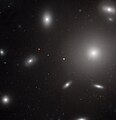Datoteka:NGC 4874 HST.jpg
Izgled

Veličina ovog prikaza: 578 × 600 piksela. Ostale razlučivosti: 231 × 240 piksela | 463 × 480 piksela | 740 × 768 piksela | 987 × 1.024 piksela | 1.973 × 2.048 piksela | 3.864 × 4.010 piksela.
Vidi sliku u punoj veličini (3.864 × 4.010 piksela, veličina datoteke: 5,95 MB, MIME tip: image/jpeg)
Povijest datoteke
Kliknite na datum/vrijeme kako biste vidjeli datoteku kakva je tada bila.
| Datum/Vrijeme | Minijatura | Dimenzije | Suradnik | Komentar | |
|---|---|---|---|---|---|
| sadašnja | 13:55, 20. rujna 2011. |  | 3.864 × 4.010 (5,95 MB) | Jmencisom |
Uporaba datoteke
Na ovu sliku vode poveznice sa sljedećih stranica:
Globalna uporaba datoteke
Sljedeći wikiji rabe ovu datoteku:
- Uporaba na ar.wikipedia.org
- Uporaba na arz.wikipedia.org
- Uporaba na ast.wikipedia.org
- Uporaba na az.wikipedia.org
- Uporaba na be.wikipedia.org
- Uporaba na ce.wikipedia.org
- Uporaba na cs.wikipedia.org
- Uporaba na de.wikipedia.org
- Uporaba na diq.wikipedia.org
- Uporaba na en.wikipedia.org
- Uporaba na et.wikipedia.org
- Uporaba na eu.wikipedia.org
- Uporaba na fr.wikipedia.org
- Uporaba na it.wikipedia.org
- Uporaba na ja.wikipedia.org
- Uporaba na kk.wikipedia.org
- Uporaba na ko.wikipedia.org
- Uporaba na mk.wikipedia.org
- Uporaba na nl.wikipedia.org
- Uporaba na pl.wikipedia.org
- Uporaba na ru.wikipedia.org
- Uporaba na sk.wikipedia.org
- Uporaba na sl.wikipedia.org
- Uporaba na tt.wikipedia.org
- Uporaba na uk.wikipedia.org
- Uporaba na uz.wikipedia.org
- Uporaba na www.wikidata.org
- Uporaba na zh.wikipedia.org
